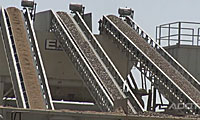Building a Freeway: Batch plant
Building a Freeway: Batch plant

Here we are, blogging about pavement … again! When we told you there’s a lot to learn on the subject, we weren’t joking.
Today’s topic has to do with how concrete pavement is made – it all starts at the batch plant.
A batch plant is where concrete pavement is mixed before it’s trucked to where it is needed. On some ADOT projects, contractors will utilize a portable plant (which is what you see in the video above).
These portable batch plants are a huge time and money saver, allowing contractors to mix concrete on a project site instead of purchasing and hauling it from an outside source. According to one estimate, mixing on site saves about 20 percent over what it would cost to purchase from a commercial plant.
But, how does the concrete actually get made? We’ll borrow an explanation from this blog post to tell you:
If you can imagine mixing a giant cake, you can visualize how concrete is made.
First the contractor has the components – cement, fly ash, aggregate (rocks) and water – delivered and placed in stockpiles around the plant. The material is then loaded onto a conveyor belt and weighed by a computer before being placed in the mixer.
In just a minute and a half the concrete is ready to be loaded onto a transport vehicle and then placed on the roadway.
But, wait … there’s more.
Want to learn some additional facts about pavement? Check out our previous posts. We’ve blogged about quiet pavement, pavement at airports, materials testing, pavement markers, the impact climate can have on pavement and how crews make sure pavement is as smooth as possible.
